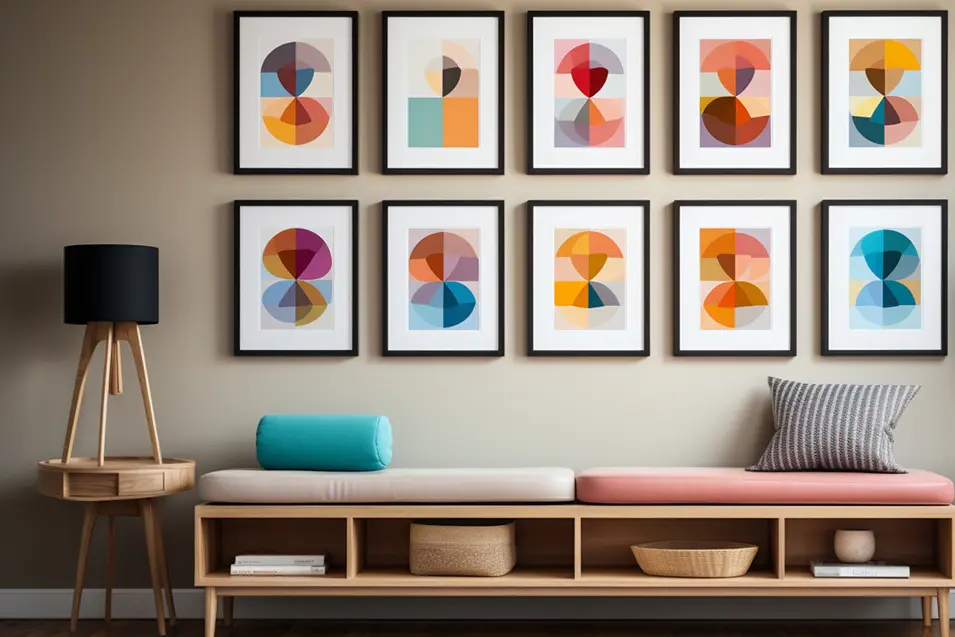Choosing Art for Your Living Room
Your living room is likely the most visible and public space in your home. It’s where your family bonds and guests are welcomed and entertained. With this in mind, you should take special care to decorate your living room to be both comfortable and visually appealing. Selecting art for your living room is a crucial decision that sets the tone for the space, so choose pieces with the specific purpose of creating a relaxing atmosphere for you, your family, and your guests.
Selecting Appropriate Subject Matter and Style
Art in a high-traffic area like the living room should have broad appeal. Many prefer abstract art for its modern, chic aesthetic and its ability to evoke different interpretations for each viewer. If you lean toward representational work, universally recognized subjects like landscapes or still-life pieces are widely appreciated. Avoid artworks with heavy or dark themes, as they may create an unsettling mood.
Pay attention to the artist’s use of color to set the mood and tone. Paintings with soft, low-contrast colors and symmetrical or traditional compositions foster a calm and inviting atmosphere. In contrast, bold, high-contrast colors often introduce drama or tension, which may not suit a relaxing living room environment.
For those who prefer sculpture, three-dimensional pieces are less common but equally suitable for living room decor. Abstract sculptures share the versatile appeal of abstract paintings. If your taste is more conservative, opt for classical subjects like busts or studies of the human form. The size and texture of a sculpture significantly influence the room’s mood, much like color and contrast do in paintings. Smooth textures and smaller sculptures create a subtle, calming effect, while large, freestanding pieces or those with rough textures add drama.
Matching Art to Your Space
Finding the Right Piece for Your Room
When selecting wall art, measure the wall where the piece will hang to determine an appropriate size. A small painting can look out of place on a large, empty wall, just as an oversized painting may overwhelm a smaller or cluttered space. Beyond size, ensure the artwork complements the room’s decor. The colors in the piece should harmonize with the living room’s color scheme without matching it exactly, as over-coordination can feel monotonous. For instance, in a living room decorated with tones of brown, tan, and cream, consider a painting that incorporates similar shades alongside a vibrant accent color, such as red or blue-gray, to create a focal point.
Three-dimensional pieces, like sculptures, require a dedicated display space, such as a table, shelf, or low-traffic floor area. Ensure the area is free of visual clutter to highlight the artwork’s beauty. Whether choosing two-dimensional or three-dimensional art, place it in a safe location. Antiques, in particular, are vulnerable to damage from direct sunlight or humidity, but all original art requires careful handling. Avoid placing art near front doors, steam heaters, or walls exposed to frequent sunlight. Heavy canvases should be securely anchored, and sculptures or ceramics must be positioned out of reach of children or pets.
Art as an Investment
While art can appreciate over time, predicting its future value is challenging. Even works by established artists can fluctuate in value due to changing trends. Investing in pieces by emerging artists carries even greater uncertainty. Additionally, art is not highly liquid; selling a valuable piece can be a slow and complex process, requiring the right buyer or auction.
However, “investment” doesn’t always mean financial return. Quality art can endure for decades or even centuries, becoming a cherished family heirloom. Whether monetarily valuable or not, artwork passed down through generations carries deep personal and sentimental value.
Choosing Art You Love
Whether you intend to pass the art to your children or replace it during your next redecoration, the most important factor is choosing something you love. Take time to research artists by visiting local galleries, exploring museums, or browsing artist websites online. Discuss art with family and friends to better understand your preferences and identify patterns in your tastes. Articulating what you like will help when communicating with gallery owners or artists during your search. Most importantly, understanding your preferences ensures you select a piece you’ll continue to cherish for years to come.





